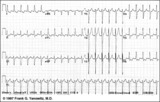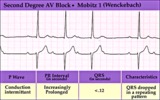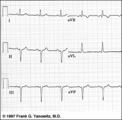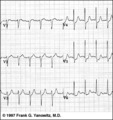The Health Education Assets Library (HEAL) is a collection of over 22,000 freely available digital materials for health sciences education. The collection is now housed at the University of Utah J. Willard Marriott Digital Library.
TO
| Title | Description | Subject | Collection | ||
|---|---|---|---|---|---|
| 201 |
 |
Extensive anterior/anterolateral MI: precordial leads | Extensive anterior/anterolateral MI: precordial leads | Knowledge Weavers ECG | |
| 202 |
 |
LVH: strain pattern + left atrial enlargement | LVH: strain pattern + left atrial enlargement | Knowledge Weavers ECG | |
| 203 |
 |
Ventricular asystole - marquette | Ventricular asystole - marquette | Knowledge Weavers ECG | |
| 204 |
 |
Multifocal PVC's - marquette | Multifocal PVC's - marquette | Knowledge Weavers ECG | |
| 205 |
 |
Atrial flutter with 2:1 AV conduction | In this example of atrial flutter with 2:1 AV conduction the flutter waves are very hard to see. Atrial flutter with 2:1 block must be considered, however, because the heart rate is about 150 bpm. A careful look at V1 shows the two flutter waves for each QRS complex complex. One flutter wave imme... | Knowledge Weavers ECG | |
| 206 |
 |
Ventricular parasystole | In ventricular parasystole, non-fixed coupled PVC's occur at a common inter-ectopic interval. Fusion beats, indicated by arrows, are often seen. Fusions occur when the sinus impulse entering the ventricles find the ventricles already partially depolarized by the parasystolic focus. | Knowledge Weavers ECG | |
| 207 |
 |
Atrial flutter with 2:1 and 4:1 conduction and rate dependent LBBB | In this example of atrial flutter with variable AV conduction, the faster rates are associated with rate-related LBBB. Don't confuse this for ventricular tachycardia. | Knowledge Weavers ECG | |
| 208 |
 |
2nd degree AV block, type I (Wenckebach) | 2nd degree AV block, type I (Wenckebach) | Knowledge Weavers ECG | |
| 209 |
 |
Diagram: stages of acute Q-wave MI | Diagram: stages of acute Q-wave MI | Knowledge Weavers ECG | |
| 210 |
 |
Accelerated junctional rhythm | Accelerated junctional rhythm | Knowledge Weavers ECG | |
| 211 |
 |
PVC's - marquette | PVC's - marquette | Knowledge Weavers ECG | |
| 212 |
 |
2nd degree AV block with junctional escapes and captures | Second degree AV block is present; conducted beats are identified by those QRS's that terminate shorter cycles than the junctional escape cycle; i.e., the 3rd and probably the 4th QRS's are captures; the other QRS's are junctional escapes. | Knowledge Weavers ECG | |
| 213 |
 |
Atrial fibrillation with moderate ventricular response - Marquette | Atrial fibrillation with moderate ventricular response - Marquette | Knowledge Weavers ECG | |
| 214 |
 |
Ventricular pacing in atrial fibrillation - marquette | Ventricular pacing in atrial fibrillation - marquette | Knowledge Weavers ECG | |
| 215 |
 |
Ventricular pacemaker: demand mode functioning | Ventricular pacemaker: demand mode functioning | Knowledge Weavers ECG | |
| 216 |
 |
Ventricular escape beat - marquette | Ventricular escape beat - marquette | Knowledge Weavers ECG | |
| 217 |
 |
LAFB: frontal plane leads | LAFB: frontal plane leads | Knowledge Weavers ECG | |
| 218 |
 |
Old infero-posterior MI | Old infero-posterior MI | Knowledge Weavers ECG | |
| 219 |
 |
2nd degree AV block, type I | The 3 rules of classic AV Wenckebach are: 1. decreasing RR intervals until pause; 2. the pause is less than preceding 2 RR intervals; and 3. the RR interval after the pause is greater than the RR interval just prior to pause. Unfortunately, there are many examples of atypical forms of Wenckebach wh... | Wenckebach AV Block | Knowledge Weavers ECG |
| 220 |
 |
Atrial echos | In this example a typical Wenckebach sequence is interrupted by what looks like a PAC - indicated by red arrows. Atrial echos are more likely, however, because the preceding beat has a long PR interval, a condition that facilitates reentry and echo formation. | Knowledge Weavers ECG | |
| 221 |
 |
Anteroseptal MI with RBBB: precordial leads | Anteroseptal MI with RBBB: precordial leads | Knowledge Weavers ECG | |
| 222 |
 |
Cardiac conduction system diagram - marquette | Cardiac conduction system diagram - marquette | Knowledge Weavers ECG | |
| 223 |
 |
ST segment depression: precordial leads | ST segment depression: precordial leads | Knowledge Weavers ECG | |
| 224 |
 |
Idioventricular escape rhythm | Idioventricular escape rhythm | Knowledge Weavers ECG | |
| 225 |
 |
Unifocal PVCs - marquette | Unifocal PVCs - marquette | Knowledge Weavers ECG |
